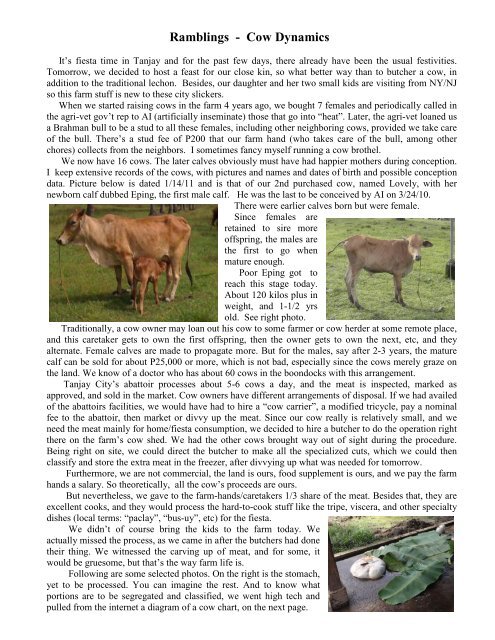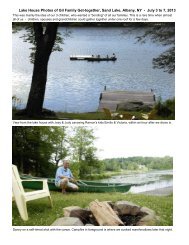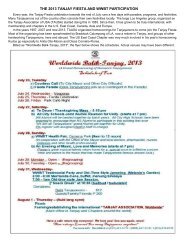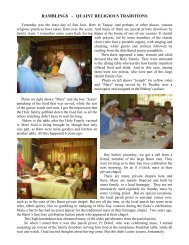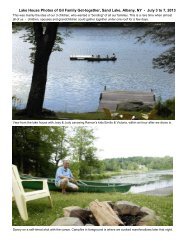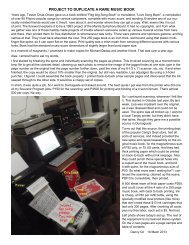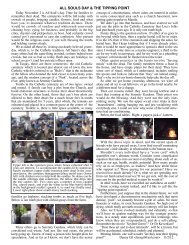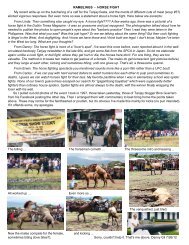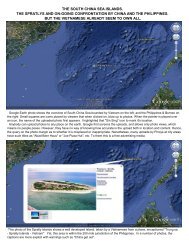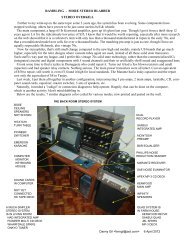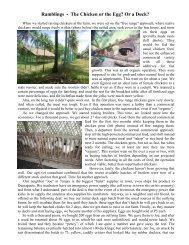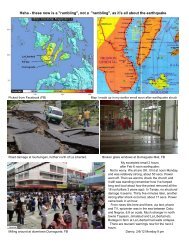Create successful ePaper yourself
Turn your PDF publications into a flip-book with our unique Google optimized e-Paper software.
<strong>Ramblings</strong> - <strong>Cow</strong> <strong>Dynamics</strong><br />
It’s fiesta time in Tanjay and for the past few days, there already have been the usual festivities.<br />
Tomorrow, we decided to host a feast for our close kin, so what better way than to butcher a cow, in<br />
addition to the traditional lechon. Besides, our daughter and her two small kids are visiting from NY/NJ<br />
so this farm stuff is new to these city slickers.<br />
When we started raising cows in the farm 4 years ago, we bought 7 females and periodically called in<br />
the agri-vet gov’t rep to AI (artificially inseminate) those that go into “heat”. Later, the agri-vet loaned us<br />
a Brahman bull to be a stud to all these females, including other neighboring cows, provided we take care<br />
of the bull. There’s a stud fee of P200 that our farm hand (who takes care of the bull, among other<br />
chores) collects from the neighbors. I sometimes fancy myself running a cow brothel.<br />
We now have 16 cows. The later calves obviously must have had happier mothers during conception.<br />
I keep extensive records of the cows, with pictures and names and dates of birth and possible conception<br />
data. Picture below is dated 1/14/11 and is that of our 2nd purchased cow, named Lovely, with her<br />
newborn calf dubbed Eping, the first male calf. He was the last to be conceived by AI on 3/24/10.<br />
There were earlier calves born but were female.<br />
Since females are<br />
retained to sire more<br />
offspring, the males are<br />
the first to go when<br />
mature enough.<br />
Poor Eping got to<br />
reach this stage today.<br />
About 120 kilos plus in<br />
weight, and 1-1/2 yrs<br />
old. See right photo.<br />
Traditionally, a cow owner may loan out his cow to some farmer or cow herder at some remote place,<br />
and this caretaker gets to own the first offspring, then the owner gets to own the next, etc, and they<br />
alternate. Female calves are made to propagate more. But for the males, say after 2-3 years, the mature<br />
calf can be sold for about P25,000 or more, which is not bad, especially since the cows merely graze on<br />
the land. We know of a doctor who has about 60 cows in the boondocks with this arrangement.<br />
Tanjay City’s abattoir processes about 5-6 cows a day, and the meat is inspected, marked as<br />
approved, and sold in the market. <strong>Cow</strong> owners have different arrangements of disposal. If we had availed<br />
of the abattoirs facilities, we would have had to hire a “cow carrier”, a modified tricycle, pay a nominal<br />
fee to the abattoir, then market or divvy up the meat. Since our cow really is relatively small, and we<br />
need the meat mainly for home/fiesta consumption, we decided to hire a butcher to do the operation right<br />
there on the farm’s cow shed. We had the other cows brought way out of sight during the procedure.<br />
Being right on site, we could direct the butcher to make all the specialized cuts, which we could then<br />
classify and store the extra meat in the freezer, after divvying up what was needed for tomorrow.<br />
Furthermore, we are not commercial, the land is ours, food supplement is ours, and we pay the farm<br />
hands a salary. So theoretically, all the cow’s proceeds are ours.<br />
But nevertheless, we gave to the farm-hands/caretakers 1/3 share of the meat. Besides that, they are<br />
excellent cooks, and they would process the hard-to-cook stuff like the tripe, viscera, and other specialty<br />
dishes (local terms: “paclay”, “bus-uy”, etc) for the fiesta.<br />
We didn’t of course bring the kids to the farm today. We<br />
actually missed the process, as we came in after the butchers had done<br />
their thing. We witnessed the carving up of meat, and for some, it<br />
would be gruesome, but that’s the way farm life is.<br />
Following are some selected photos. On the right is the stomach,<br />
yet to be processed. You can imagine the rest. And to know what<br />
portions are to be segregated and classified, we went high tech and<br />
pulled from the internet a diagram of a cow chart, on the next page.
But farm talk is matter-orfactly,<br />
and oftentimes raw, and<br />
between the butcher, our farm<br />
hands and us, the talk got to be<br />
about the more exotic anatomy:<br />
such as what to do with the<br />
skin, head, brain, viscera, hoofs,<br />
tongue, lungs, tail, reproductive<br />
organs, etc. This is not all<br />
shown on the chart.<br />
Soup #5 is made from a<br />
certain male anatomical part, a<br />
well known delicacy and a<br />
reputed aphrodisiac. I told them<br />
to retain that part for us.<br />
The female counterpart is reputedly good to loosen the tongues of children who are slow in talking.<br />
Below is Lisa directing the butcher. That’s only part of the meat spread out on banana leaves on<br />
the floor, mostly ribs. The sirloin, chuck, leg and romp portions already were loaded in the van.<br />
Above photo is at the house, where further sorting was<br />
made. Even after separating all the needs for the fiesta<br />
tomorrow, and packing up more portions for our cousins<br />
and maids to take home, there still was a lot left over from<br />
the 70 kilos net from the cow. Not bad at all, considering<br />
this was all organic meat. We wrapped, then labeled them<br />
before storing in the freezer, as shown in next photos.<br />
Later this afternoon,<br />
we’ll go off to<br />
see the parade, then<br />
the horse fight event,<br />
and later the evening<br />
program at the plaza.<br />
Needless to say,<br />
the soup #5 was<br />
delicious this noon.<br />
But only I ate it.<br />
Danny Gil 23 July 2012


